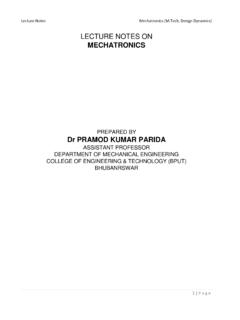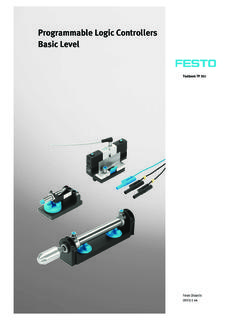Transcription of Programmable Logic Controllers
1 Programmable Logic Controllers Programmable Logic Controllers Fourth Edition W. Bolton AMSTERDAM BOSTON HEIDELBERG LONDON NEW YORK OXFORD. PARIS SAN DIEGO SAN FRANCISCO SINGAPORE SYDNEY TOKYO. ELSEVIER Newnes is an imprint of Elsevier Newnes Newnes is an imprint of Elsevier Linacre House, Jordan Hill, Oxford OX2 8DP. 30 Corporate Drive, Suite 400, Burlington, MA 01803. First edition 1996. Second edition 2000. Third edition 2003. Fourth edition 2006. Copyright 2006, W. Bolton. Published by Elsevier Newnes. All rights reserved The right of W.
2 Bolton to be identified as the author of this work has been asserted in accordance with the Copyright, Designs and Patents Act 1988. No part of this publication may be reproduced, stored in a retrieval system or transmitted in any form or by any means electronic, mechanical, photocopying, recordinh or otherwise without the prior permission of the publisher Permissions may be sought directly from Elsevier's Science & Technology Rights Department in Oxford, UK; phone: (+44) 1865 843830; fax: (+44) (0) 1865 853333;. e-mail: Alternatively you can submit your request on-line by visiting the Elsevier web site at , and selecting Obtaining permission to use Elsevier material Notice No responsibility is assumed by the publisher for any injury and/or damage to persons or property as a matter of products liability, negligence or otherwise, or from any use or operation of any methods, products, instructions or ideas contained in the material herin.
3 Because of rapid advances in the medical sciences, in particular, independent verification of diganoses and drug dosages should be made British Library Cataloguing in Publication Data A catalogue record for this book is available from the British Library Library of Congress Cataloging -in-Publication Data A catalog record for this book is available from the Library of Congress ISBN-13: 978-0-7506-8112-4. ISBN-10: 0-7506-8112-8. For information on all Newnes publications visit our website at Printed and bound in the UK. 06 07 08 09 10 10 9 8 7 6 5 4 3 2 1.
4 Working together to grow libraries in developing countries | | BOOK AID Sabre Foundation ELSEVIER International Contents Preface vii 1 Programmable Logic Controllers 1. Controllers Hardware 4. Internal architecture 5. PLC systems 10. Problems 15. 2 Input-output devices Input devices 17. Output devices 30. Examples of applications 39. Problems 41. 3 Number systems The binary system 44. Octal and hexadecimal 45. Binary arithmetic 47. PLC data 51. Problems 52. 4 I/O processing Input/output units 53. Signal conditioning 59. Remote connections 62.
5 Networks 69. Processing inputs 75. I/O addresses 76. Problems 77. 5 Ladder and functional Ladder diagrams 80. block programming Logic functions 84. Latching 90. Multiple outputs 91. Entering programs 93. Function blocks 94. Program examples 100. Problems 103. 6 IL, SFC and ST Intruction lists 108. programming methods Sequential function charts 115. Structured text 120. Problems 124. 7 Internal relays Internal relays 132. Ladder programs 133. Battery-backed relays 136. vi Contents One-shot operation 137. Set and reset 138. Master control relay 142.
6 Problems 146. 8 Jump and call Jump 154. Subroutines 156. Problems 157. 9 Timers Types of timers 159. Programming timers 160. Off-delay timers 163. Pulse timers 165. Programming examples 166. Problems 167. 10 Counters Forms of counter 173. Programming 174. Up and down counting 178. Timers with counters 179. Sequencer 180. Problems 182. 11 Shift registers Shift registers 189. Ladder programs 190. Problems 194. 12 Data handling Registers and bits 197. Data handling 198. Arithmetic functions 202. Closed loop control 203. Problems 206.
7 13 Designing systems Program development 210. Safe systems 214. Commissioning 218. Fault finding 220. System documentation 227. Problems 248. 14 Programs Temperature control 250. Valve sequencing 254. Conveyor belt control 265. Control of a process 269. Problems 271. Appendix: Symbols 276. Answers 281. Index 288. Preface Technological advances in recent years have resulted in the development of the Programmable Logic controller and a consequential revolution of control engineering. This book is an introduction to Programmable Logic Controllers and aims to ease the tasks of practising engineers coming first into contact with Programmable Logic Controllers , and also provides a basic course for students on courses such as Nationals and Higher Nationals in Engineering, company training programmes and as an introduction for first year undergraduate courses in engineering.
8 The book has been designed to provide full syllabus coverage of the BTEC National and Higher National in Engineering units Programmable Controllers and Programmable Logic Controllers from Edexcel. It addresses the problem of different Programmable control manufacturers using different nomenclature and program forms by describing the principles involved and illustrating them with examples from a range of manufacturers. The text includes: w The basic architecture of PLCs and the characteristics of commonly used input and outputs to such systems.
9 W A discussion of the number systems: denary, binary, octal, hexadecimal and BCD. w A painstaking methodical introduction, with lots of illustrations, of how to program PLCs, whatever the manufacturer, and make use of internal relays, timers, counters, shift registers, sequencers and data handling facilities. w Consideration of the standards given by IEC 1131-3 and the programming methods of ladder, functional block diagram, instruction list, structured text and sequential function chart. w To assist the reader to develop the skills necessary to write programs for Programmable Logic Controllers , many worked examples, multi-choice questions and problems are included in the book with answers to all multi-choice questions and problems given at the end of the book.
10 Changes from third edition The fourth edition is a complete restructuring and updating of the third edition and includes a more detailed consideration of IEC 1131-3, including all the programming methods given in the standard, and the problems of safety. This includes a discussion of emergency stop relays and safety PLCs. viii Preface Aims This book aims to enable the reader to: w Identify and explain the main design characteristics, internal architecture and operating principles of Programmable Logic Controllers . w Describe and identify the characteristics of commonly used input and output devices.






